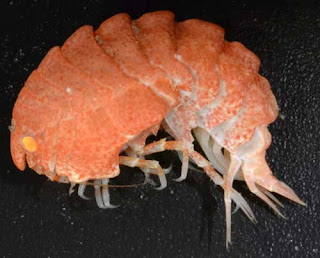Epimeria georgiana (up to 35 mm). This epimeriid amphipod is common near the tip of the Antarctic Peninsula and around the Antarctic islands, which prolongates it farther north, up to South Georgia.
Waldeckia obesa is another common and very characteristic amphipod of Antarctic seas.
I sleep until 11:30, just in time for lunch. The sea is open; no more ice except a tabular iceberg afar. There is a light haze, so the sky is white but luminous, we are steaming towards the Antarctic Sound, i.e. the straight between Joinville island and the tip of the Antarctic Peninsula. I am identifying the material collected yesterday. At 13:00 the sun shines through the haze. However at 13:35 we dive in the mist and it becomes very dark. We see nothing when we enter the Antarctic sound; we just guess the occurence of an island, of which we can scarcely discern the basis through the fog. At 16:44, we suddently enter again into the ice. 17:30 alternance of ice and patches of open waters. During the evening the ship has to modify its course in order to avoid a huge (many kilometers long) tabular iceberg. As the fog has disappeared at that time, we could make nice pictures of it. Late in the evening, the sun is shining brightly on the southern part of the Antarctic Sound. Iceflows and icebergs are standing everywhere on a peaceful sea, with the mainland in background. The play of light and shadow looks as out of this world: we are in the realm of the ice fairy. This scenery is truly mesmerizing, never to forget.
(Cédric)
09.02.2013 (Saturday). I wake up around noon, hoping to
enjoy the beautiful view of the Bransfield Sound, but the weather’s incredibly
foggy and you can’t see anything further than maybe 20 meters. We’re in open
water again. We’re steaming all day long to the next station and should arrive
late in the evening. Later on, the fog dissolves a bit : it’s an ocean of snow
now and we can see bits of mountains profiling in the horizon. We see the
continent at last! It’s the end of the Sound, we’re going out. Later on, the
fog is completely gone, everyone gathers on the deck to look at a huge tabular
iceberg which forms a high wall in front of the ship, forcing us to change our
trajectory in order to outline it. It’s really impressive, you can’t see the
end of it. It looks like the continental ice-shelf and is probably a big piece
of it which broke and drifted away. The
scenery begins to get even more beautiful as time goes by, we arrive in Erebus
and Terror Bay and are surrounded by its islands. It’s the first time in this
cruise we really could look at the land in a clear sky. With the sunny weather,
the big icebergs and smaller drifting ice-plates, some high and rocky islands,
some very elongated, rounder and white from the snow: an amazing view and
feeling, once again.
(Marie)
Ice and black sky.
This iceberg is many kilometers long and it forced the Polartsern to modify her course.
Realm of the ice fairy.
(Pictures by Cédric)






No comments:
Post a Comment